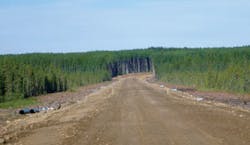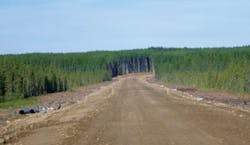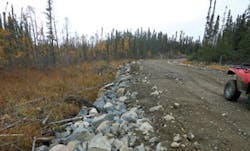Canada's boreal region is a vast area covered with trees, rivers, lakes, and wetlands. It is one of North America's most important nesting areas for millions of ducks, geese and other birds. The boreal is also rich in natural resources, such as forests, oil, gas, and minerals, on which we depend every day. We access these resources through roads, which in turn can have impacts on the ecosystems that we value, such as the boreal's abundant wetlands. This is why FPInnovations, Ducks Unlimited Canada and their partners are working with Sustainable Forestry Initiative® Inc. (SFI) to improve knowledge of wetland management.
Through this unique partnership, FPInnovations is currently conducting research to support the Canadian forest sector. They are endeavoring to mitigate the impacts of road construction on boreal forest wetlands and waterfowl habitats across Canada through the creation of a best management field guide for resource roads. SFI is dedicated to fostering partnerships with organizations that are committed to improving forest management practices across North America and brings groups such as FPInnovations and Ducks Unlimited Canada together.
This national work builds off a project that SFI sponsored over the course of three years in the boreal plains of Saskatchewan and Manitoba. That particular project also engaged FPInnovations, Ducks Unlimited Canada and SFI-certified companies LP Building Products and Weyerhaeuser, so it's no surprise that these partners are all working together once again. Over the course of the three-year project, the partners identified five classes of wetlands in the boreal plains. By better understanding wetland types in the boreal forest, it is easier for road construction planners to design the types of crossings they will need. The new national project will expand our understanding of the boreal forest wetlands and work towards conserving the health of our future forests.
Resource Roads in the Boreal Forest
Resource roads are constructed in the boreal forest to support many industrial, recreational and public activities. These roads predominantly see low traffic volumes and are built in cost-efficient manners using materials available on-site. For the forest sector, roads have long been built throughout the Canadian boreal forest in support of forest management activities. As forest management continues to be performed, forest companies and governments are ensuring that road construction is conducted in an economical and environmentally sustainable manner. Other resource sectors, such as mining and oil and gas exploration, are ensuring that their road construction activities take into account the processes and values of the wetlands in the boreal forest.
Importance of Responsible Management
The boreal forest wetlands are not widely understood. They are distinguishable because they are submerged or permeated by water -- either permanently or temporarily -- and also by their plants, which have adapted to saturated soil conditions. Wetlands can consist of fresh and saltwater marshes, swamps, bogs and fens, ponds, and seasonally flooded forests.
A high concentration of animals can be found in Canada's wetlands, including waterfowl, ducks, geese, loons, herons, mallards, swans, minks, raccoons, moose, fish, invertebrates, and some endangered species. With over 450 species of birds found in Canada, half of them use the boreal forest, and up to five billion migrate south and back each year. Many of these animals rely heavily on the wetlands to provide shelter and food and would become displaced if food supplies were disrupted or the wetlands were to disappear altogether.
With Canada being home to 25 percent of the world's boreal forests, it occupies over 6,000,000 square kilometers, of which more than 30 percent is boreal wetlands. Although Canada's boreal forest contains large wilderness areas (with about half still undisturbed by roads, cities or industrial development), landscape changes, resource development and climate change all have impacts on its natural resources and wildlife.
Wetlands benefit humanity greatly by providing flood control, storage of carbon, water purification/filtration, and shoreline protection. The more we understand how human activity impacts wetlands, the more we can work towards sustainable solutions to conserving wetlands and the wildlife that relies on it. Collaboration between SFI, Ducks Unlimited Canada, FPInnovations, and SFI program participants, is supporting responsible management of the boreal forest wetlands.
Sustainable Solutions
Road development may have impacts on waterfowl habitat as well as wetland hydrology. However, there is considerable uncertainty that remains regarding the impacts that these resource roads have on wetland processes and ecological values. There has been some debate surrounding what the most effective planning, construction and maintenance methods are when it comes to reducing the impacts of resource roads on wetlands.
Because of this knowledge gap and acknowledgment that sustainable solutions are needed sooner rather than later, FPInnovations and its partners are currently conducting on-the-ground research that will influence the creation of a best practices field guide. Once completed, the field guide will outline approaches to constructing roads, which will minimize the impact that resource developments have on wetland areas and waterfowl habitat, as well as hasten recovery of the site. These solutions will allow wetlands and resource roads to co-exist while at the same time protecting the health of our future forests.
Through its research, the partnership intends to advance the understanding of the biological and ecological impacts of resource roads on wetland processes; the effectiveness of road drainage improvement methods for maintaining natural drainage processes and the water balance of wetlands; the long-term structural performance of existing road and foundation improvement methods; and development of innovative road and foundation improvement methods and subsequent controlled field tests. Likewise, the partners' research capabilities, which focus on the operational aspects of resource road construction, will address many of these concerns.
FPInnovations and its partners will continue to conduct a variety of research activities that will improve our knowledge about the impacts of current road construction on wetlands. Once existing practices are more completely understood and new innovative methods are identified, the best practices field guide will be completed. It is expected to be ready for distribution in 2016.
About the Authors: FPInnovations (fpinnovations.ca) is a not-for-profit that specializes in the creation of scientific solutions in support of the Canadian forest sector's global competitiveness. SFI Inc. (sfiprogram.org) is an independent, nonprofit organization that is solely responsible for maintaining, overseeing and improving the internationally recognized Sustainable Forestry Initiative® (SFI®) program across the U.S. and Canada.





